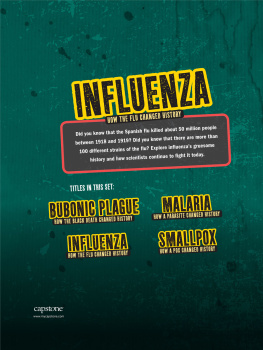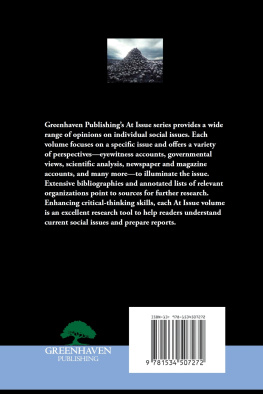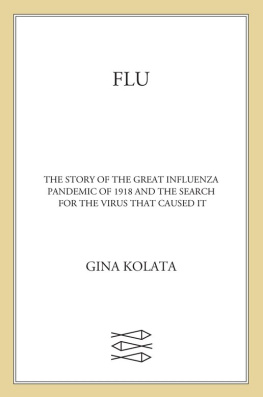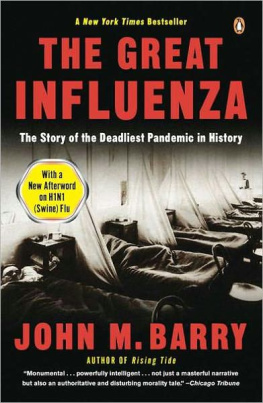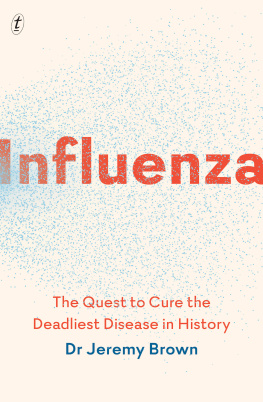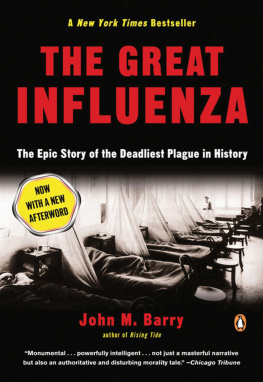The 1918 flu was commonly called the Spanish flu because news of it first spread in Spain. But the Spanish called it the French flu because they believed it started in France.
Law was not the only soldier on the ship to come down with the flu. Many others did too. Soon the ships dining room had to be converted into a hospital. Law and other ill passengers were packed together. Law remembered, They put two tables together and thered be two of us, and I, my head was next to the feet of the guy next to me.... We had little pads, but that didnt amount to much. For about one week, Law cycled through periods of fever and delirium. The bodies of men who died from the flu were tossed out to sea. By the time the ship arrived in France in October 1918, 91 soldiers had died from the flu. But Law was fortunate. He survived.
FLU OUTBREAKS
The 1918 Spanish flu was not the first deadly flu outbreak. The first known widespread flu outbreak occurred in 1510. It started in Africa and spread to Europe. In 1580 another flu spread. It began in Asia. Then it spread to Africa, Europe, and North America. It became a global outbreak in just six weeks. In 1889 a flu outbreak began in Russia. It spread quickly throughout Europe. It then affected North America, South America, and Asia. About 1 million people died from the Russian flu.
FLU SYMPTOMS
The flu is a when an infected person coughs or sneezes. A healthy person breathes in the virus. The virus multiplies inside a persons body. It attacks the nose, throat, and lungs.
There are many different flu symptoms. The illness can come on suddenly with chills, fever, and headaches. builds up in a persons lungs. This leads to coughing and muscle pain. In the most severe cases, people experience delirium.
A fever is a common symptom in the early stages of the flu.
FLU TYPES
There are four types of influenza viruses. They are called A, B, C, and D. Influenza C viruses usually cause mild illness. Influenza D viruses tend to infect only cattle. These viruses have never infected people. Influenza A and B types are the seasonal flu. In the United States, the seasonal flu appears every fall and winter.
swine flu under a microscope
Influenza A has subtypes based on combinations of two different proteins. These proteins are found in the virus. They are called hemagglutinin (H) and neuraminidase (N). Different subtypes are called strains. There are more than 100 different strains of influenza A based on different H and N combinations. The most well-known example of a dangerous flu strain is H1N1. This strain caused the Spanish flu.
Influenza viruses are first carried in the guts of wild birds. Some of these viruses can be transmitted directly from birds to humans. This type of influenza is called the bird flu.
Some flu strains are passed from birds to pigs. This type of influenza is called the swine flu. The virus then can pass from pigs to humans.
FAST FACT
Birds or pigs can spread the H1N1 virus to humans. Scientists are not sure which type of animal spread the 1918 Spanish flu to humans.
CHAPTER 2
THE SPANISH FLU
Most historians today think the Spanish flu started in Asia. Because the flu spread around the world in 1918, it was called a symptoms right away. They did not know that they carried the virus.
Volunteers for the American Red Cross prepare stretchers to carry flu victims in 1918.
Infected soldiers traveled to other parts of the United States. They spread the flu to other people. Some people died just hours after they first developed symptoms. The virus quickly spread throughout big cities such as Philadelphia and New York. It also spread to smaller communities.
Ships carrying soldiers or goods to other countries also carried the flu virus. Soon the flu had spread to many places around the world, including Europe, Africa, and South America.
Doctors and nurses tried to treat soldiers who came down with the flu.
FAST FACT
Ohios Camp Sherman had more deaths from the flu than any other U.S. military camp. Nearly 1,200 soldiers at Camp Sherman died in 1918.
FIGHTING THE FLU
People in 1918 did not know the exact cause of the flu. But they did understand that flu germs were spread through the air. Some families sealed up their homes. Flu survivor Lee Reay lived in Utah at the time. He remembered that one family closed up every possible avenue of letting fresh air into the house.... They plugged up keyholes on the door, sealed windows, and stayed inside, breathing their own air.
Some soldiers rinsed their mouths with salt and water, a method they thought would help get rid of the flu.
Communities came up with some ways to fight the flu. Public spaces such as schools were closed. It became illegal in many places for people to gather in crowds. These measures did reduce the number of flu cases. But the flu still spread quickly.
Doctors could treat the symptoms of the flu. They used a new medicine called aspirin. Aspirin helped to reduce fever, swelling, and pain. But it did not cure people of the flu. Between September 1918 and March 1919, the Spanish flu killed about 50 million people. This was about 3 percent of the worlds population. Overall one-third of the globe fell ill.
FLU MASKS
Between 1918 and 1919 public health officials gave flu masks to millions of people in the United States. They ordered people to wear these masks. They hoped the masks would keep people from getting the flu. The masks were worn over the mouth and nose. People who didnt wear masks were forced to pay a fine. They also were not allowed to take public transportation. But the masks did not work very well. They were made from thin fabric, such as cotton or linen. The virus could still pass through spaces in the masks. Todays flu masks are more effective. They are made of thicker fabric that does not allow viruses to pass through.

